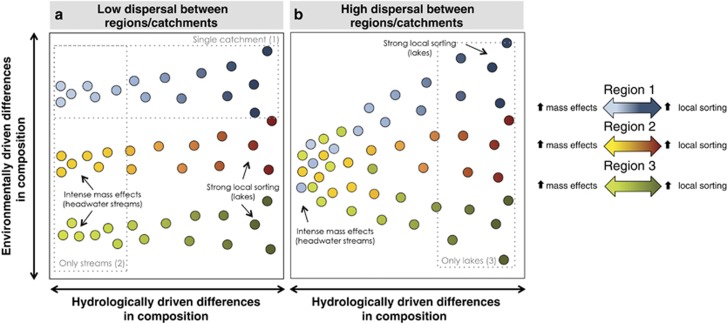Figure 1.
Schematic representation of potential large-scale spatial patterns in bacterioplankton taxonomic composition across freshwater networks, where dots represent individual bacterioplankton communities in an ordination space, based on their compositional dissimilarity, and colors indicate the different catchments or geographic regions to which they belong. Owing to the movement of the water in the landscape, the composition of local bacterioplankton communities within a single catchment or region will differ depending on their position along the hydrologic continuum (horizontal axis), as they will be differentially affected by hydrology that regulates the mass effects versus environmental sorting ratio (see Introduction section for further explanation), represented here by the light to dark color gradient. As a result, the compositional variation because of local conditions (vertical axis) will likely increase along the hydrologic continuum because of a gradual intensification of the local sorting of species with increasing WRT. Over broader spatial scales, the increase in environmental differences will likely result in stronger environmentally driven dissimilarities between communities (that is, along the vertical axis), but the overall large-scale spatial patterns may further differ depending on the degree of dispersal of microbes between regions or catchments: For example, in a case of low dispersal between regions (a), a regional structuring of the communities may be detected even in systems with little or no environmental sorting (that is, headwater streams) because the regional bacterial pools are different due to dispersal limitation. In contrast, under a scenario of high dispersal between regions (b), a common bacterial pool will lead to little environmentally driven compositional differences in the headwaters but to a increasing differentiation of communities toward downstream systems (that is, lakes) because of stronger local sorting of species. From this perspective, whereas communities located at the headwaters of the aquatic continuum will mostly reflect the nature of the regional bacterial pools because of strong mass effects, communities located further downstream in the network will be the result of species sorting by the local aquatic conditions. The interpretation of the factors and mechanisms underlying the observed spatial patterns in bacterial community composition will thus depend on the portion of this complex space that is considered (dotted areas, scenarios 1, 2 and 3). For example, studies based on a narrow spatial scale, as depicted in scenario 1, may conclude that hydrology is the main driver of changes in bacterioplankton community composition. In contrast, studies that cover broader environmental gradients but are limited to certain portions of the hydrologic continuum (scenarios 2 and 3) may conclude that either dispersal limitation (2) or local sorting (3) shape local community assembly. We argue that a cross-regional, whole network approach is necessary to disentangle the influence of the mechanisms and factors that are actually influencing the local assembly of bacterioplankton communities in complex freshwater networks.

